Knitting designs are detailed plans with instructions for creating specific knitted items like sweaters, scarves, or blankets. They guide crafters through materials, stitches, and techniques, ensuring successful projects for all skill levels.
1.1 What Are Knitting Designs?
Knitting designs are detailed plans or blueprints that guide crafters in creating specific knitted items, from blankets and sweaters to hats and accessories. These designs often include step-by-step instructions, stitch patterns, and material requirements, making it easier for knitters of all skill levels to follow along. Whether you’re a beginner or an experienced knitter, knitting designs provide a clear roadmap to bring your project to life. They can be found in various forms, such as written patterns, charts, or video tutorials, ensuring that everyone can create beautiful and functional knitted items with confidence.
1.2 Importance of Instructions in Knitting
Instructions are the backbone of successful knitting projects, providing clear guidance to achieve desired results. They help knitters understand techniques, materials, and patterns, ensuring projects are completed efficiently and effectively. For beginners, instructions serve as a learning tool, breaking down complex stitches and methods into manageable steps. Even experienced knitters rely on instructions to master intricate designs or explore new styles. By following instructions, knitters minimize errors, saving time and yarn. Clear instructions also enhance creativity, allowing crafters to personalize projects while maintaining a professional finish; They are essential for consistency, ensuring that every stitch and row aligns with the intended design.
1.3 Benefits of Following Knitting Patterns
Following knitting patterns offers numerous benefits, ensuring projects turn out as envisioned. Patterns provide a roadmap, reducing guesswork and saving time. They help maintain consistency in stitch count, tension, and overall sizing. Knitters can achieve professional finishes by adhering to structured steps. Patterns also simplify complex techniques, making them accessible to all skill levels. They guide yarn and needle selection, preventing waste and ensuring the best material for the design. Additionally, patterns allow for creativity within a framework, enabling personalization while maintaining project integrity. This structured approach boosts confidence, especially for beginners, and ensures a satisfying knitting experience from start to finish.
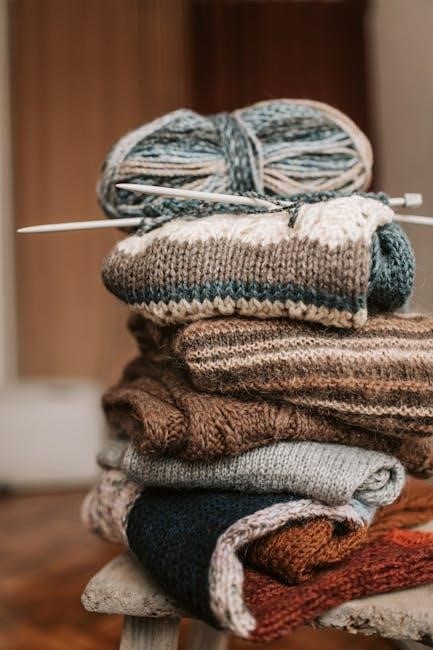
Types of Knitting Patterns
Explore various knitting patterns, including blankets, sweaters, hats, scarves, baby items, and accessories, each offering unique designs and creative possibilities.
2.1 Blanket Knitting Patterns
Blanket knitting patterns are incredibly diverse, offering designs for every skill level and home decor style. From cozy afghans to elegant throws, these patterns often feature intricate stitches or simple textures. They allow for creativity with yarn choices and color combinations, making each blanket unique. Blankets are great for beginners, as they typically involve straightforward stitches, and are ideal for practicing consistency. Experienced knitters can explore complex patterns like cables or lace. Whether for personal use or as a thoughtful gift, blanket patterns provide endless possibilities for both functionality and artistic expression in knitting.
2.2 Sweater and Jumper Knitting Patterns
Sweater and jumper knitting patterns offer a wide range of styles, from classic crew necks to trendy oversized designs. These patterns often focus on achieving the perfect fit, with options for different body types and preferences. They typically include detailed instructions for shaping, such as raglan sleeves, V-necks, or cable details. Yarn choice plays a significant role in comfort and durability, while color variations allow for personalization. Many patterns also provide tips for customizing features like sleeve length or neckline style. Whether you’re a beginner or an experienced knitter, sweater patterns cater to all skill levels with clear, step-by-step guidance.
2.3 Hat and Scarf Knitting Patterns
Hat and scarf knitting patterns are popular for their versatility and simplicity. They offer a variety of styles, from beanies to slouch hats, and scarves ranging from lightweight lace to thick, warm cables. These patterns are ideal for beginners, as they require minimal shaping and can be completed quickly. Many designs include options for customization, such as adding pom-poms or tassels. Scarf patterns often focus on repeating stitches, making them meditative and easy to follow. Hats, meanwhile, provide an excellent way to practice working in the round. Both are perfect for gifts or personal use, offering endless possibilities for creativity and practicality.
2.4 Baby Knitting Patterns
Baby knitting patterns are adorable and rewarding projects, offering a wide range of designs for infants and toddlers. From cozy booties and onesies to soft blankets and sweaters, these patterns cater to the unique needs of little ones. Many designs feature simple, repetitive stitches, making them accessible for beginners. Soft, safe yarns are often recommended to ensure comfort and durability. Patterns may include sizing options to accommodate different ages and preferences. Baby knitting projects are not only practical but also heartfelt gifts for new parents. They provide an opportunity to create something truly special and cherished, with attention to detail and care.
2.5 Accessories Knitting Patterns
Accessories knitting patterns offer a variety of stylish and functional designs, perfect for complementing any outfit. From hats, scarves, and gloves to bags, belts, and jewelry, these patterns allow knitters to create practical yet fashionable items. Many designs are quick to complete, making them ideal for gifts or personal use. Patterns often include options for customization, such as different colors, textures, or embellishments. Accessories knitting is great for using up leftover yarn and experimenting with new techniques. Whether you’re a beginner or an advanced knitter, these patterns provide endless creativity and versatility to enhance your wardrobe or home decor.
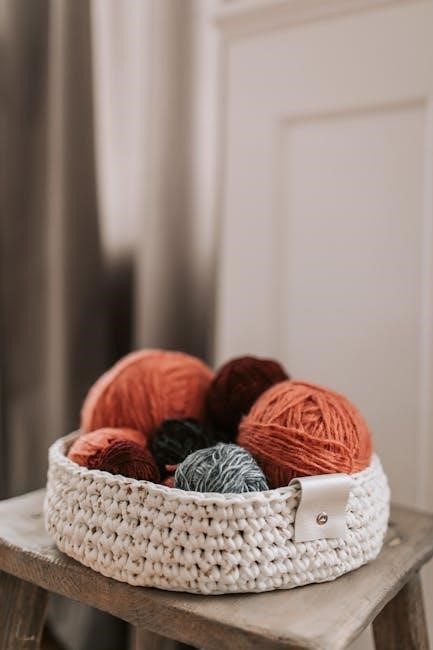
Understanding Knitting Instructions
Mastering knitting instructions involves learning basic terminology, reading patterns, and interpreting charts or symbols. Clear understanding ensures accurate stitch execution and successful project completion for all skill levels.
3.1 Basic Knitting Terminology
Understanding basic knitting terminology is essential for interpreting patterns and instructions. Common terms include cast on, knit, purl, row, stitch, yarn over, bind off, gauge, and ribbing. These terms describe fundamental actions and elements in knitting, ensuring clarity in following designs. Familiarizing yourself with these basics helps you grasp more complex techniques and communicate effectively with patterns and tutorials. Clear terminology is the foundation for successful knitting projects, allowing you to execute stitches accurately and achieve the desired results. Mastering these terms is the first step in unlocking the world of knitting designs and instructions.
3.2 Reading Knitting Patterns for Beginners
Reading knitting patterns can seem daunting, but breaking them down simplifies the process. Patterns typically include details like gauge, needle size, yarn weight, and stitch abbreviations. Understanding these elements ensures accurate execution. Start by identifying the materials and tools needed, then focus on the step-by-step instructions. Pay attention to abbreviations and symbols, as they represent specific stitches. Beginners should practice basic stitches before tackling a pattern. Highlighting unfamiliar terms and referencing tutorials can aid comprehension. Always swatch to verify gauge, as it impacts the finished size. Patience and practice will help you master reading knitting patterns confidently and effectively.
3.3 Interpreting Knitting Charts and Symbols
Knitting charts and symbols are visual representations of stitches, making patterns easier to follow. Each symbol corresponds to a specific stitch or action, such as knit, purl, or cable. Charts often depict rows or rounds, with symbols arranged to show the sequence. To interpret them, start by identifying the key or legend provided with the pattern. Read charts from bottom to top and right to left, as knitting progresses row by row. Use highlighters or markers to track your progress. Consistency is key, as misreading a symbol can alter the design. Practice decoding charts to enhance your knitting skills and confidence.
3.4 Understanding Abbreviations in Knitting
Abbreviations are shorthand terms used in knitting patterns to make instructions concise. Common abbreviations include k for knit, p for purl, st for stitch, and rep for repeat. Understanding these abbreviations is crucial for accurately following patterns. Always refer to the glossary or key provided with the pattern, as abbreviations can vary. Practice memorizing frequently used terms to improve your knitting efficiency. Misreading abbreviations can lead to errors, so double-checking is essential. Mastering knitting abbreviations enhances your ability to interpret patterns and ensures successful project completion.
Choosing the Right Yarn and Needles
Selecting the right yarn and needles is crucial for achieving the desired fabric texture and drape. They must match your project’s requirements for optimal results. The right tools enhance the knitting experience, ensuring a professional finish.
4.1 Guide to Selecting Yarn for Your Project
Selecting the right yarn is essential for your knitting project’s success. Consider the fiber type, weight, and texture to match your desired outcome. Acrylic, wool, and cotton are popular choices, each offering unique qualities. Yarn weight, measured as lace, fingering, worsted, or chunky, affects the fabric’s density and drape. Always check the gauge on the label to ensure compatibility with your needles and pattern; Think about the season and intended use—breathable yarns for summer, durable ones for blankets. Touching the yarn can reveal its softness and stitch definition. Reading labels carefully and testing swatches helps ensure the perfect match for your design.
4.2 Importance of Needle Size in Knitting
Needle size plays a crucial role in achieving the desired texture and fit in knitting. Using the correct needles ensures proper tension, preventing fabric from being too tight or too loose. Smaller needles create denser stitches, while larger needles produce looser, more airy fabrics. The wrong size can lead to discomfort in garments or structural issues in items like blankets. Always check the pattern for recommended needle sizes, as they are tailored to the specific yarn and stitch type. Testing with a gauge swatch helps confirm accuracy. Proper needle size ensures your project turns out as intended, making it both functional and visually appealing.
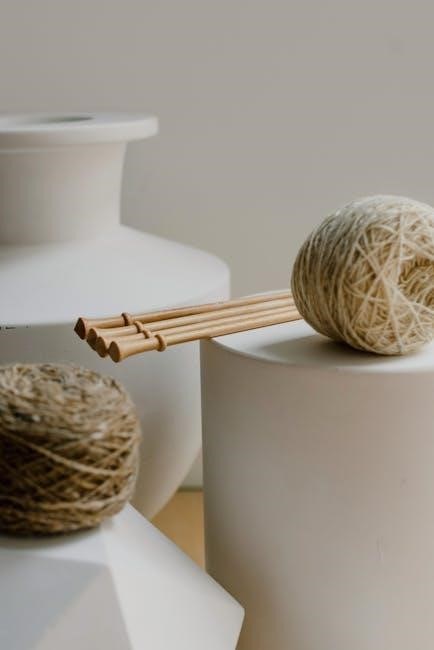
Basic Knitting Stitches
Mastering basic stitches is essential for knitting. Garter, Stockinette, Rib, and Moss stitches form the foundation of most patterns, allowing versatility and creativity in knitting designs.
5.1 Garter Stitch Tutorial
The Garter Stitch is a fundamental knitting stitch that creates a textured, ridge-and-valley pattern. It is formed by knitting every stitch in every row. This stitch is perfect for beginners, as it requires minimal technique and is forgiving. To work the Garter Stitch, cast on your desired number of stitches and knit each row without purling. This stitch is excellent for creating dense, warm fabrics and is often used in blankets, scarves, and hats. For best results, maintain even tension to ensure a neat and consistent texture. Practice this stitch to build a strong foundation for more complex knitting designs.
5.2 Stockinette Stitch Instructions
The Stockinette Stitch is a versatile and widely used knitting stitch that creates a smooth, flat fabric. To work the Stockinette Stitch, knit one row and purl the next. Repeat this sequence to create the iconic “V” pattern on the right side and small bumps on the wrong side. This stitch is ideal for garments requiring drape, such as sweaters and hats. It is essential to maintain consistent tension to avoid fabric distortion. Stockinette Stitch tends to curl at the edges, so adding a border or ribbing is often recommended. It works well with most yarn weights and needle sizes, making it a favorite for both beginners and experienced knitters.
5.3 Rib Stitch Patterns
The Rib Stitch is a flexible and elastic knitting pattern commonly used for hems, cuffs, and neckbands. It is created by alternating knit and purl stitches in the same row. This stitch is highly versatile and reversible, making it ideal for garments that require stretch, such as sweaters, hats, and scarves. Rib Stitch patterns are easy to learn and work well for both beginners and experienced knitters. They are also great for creating textured, visually appealing designs. The elasticity of the Rib Stitch ensures a comfortable fit, making it a popular choice for a wide range of knitting projects.
5.4 Moss Stitch Guide
The Moss Stitch, also known as the Seed Stitch, is a versatile knitting pattern that creates a subtle, textured fabric. It is formed by alternating single knit and purl stitches in each row, resulting in a design that appears like small seeds or moss. This stitch is ideal for scarves, blankets, and baby clothes, as it produces a soft, flexible, and reversible fabric. The Moss Stitch is easy to learn and works well for beginners. It is also a popular choice for projects requiring a simple yet elegant texture. Its subtle pattern makes it a great option for showcasing variegated yarns.
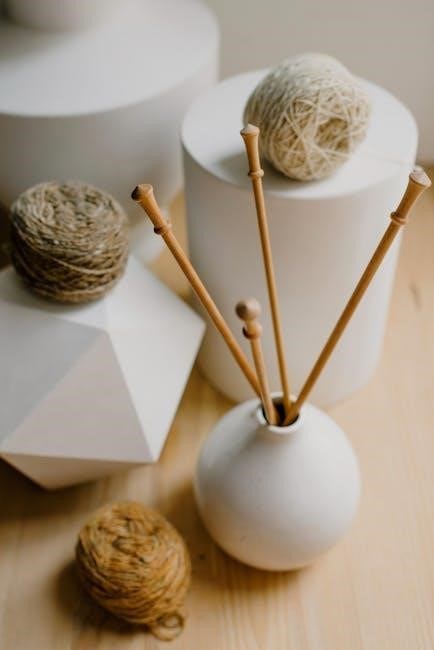
Advanced Knitting Techniques
Advanced knitting techniques like cables, lace, and Fair Isle knitting offer complexity and creativity. They allow knitters to create intricate patterns and textured designs, enhancing their projects.
6.1 Cables and Lace Knitting
Cables and lace knitting are advanced techniques that add complexity and elegance to designs. Cables involve crossing stitches over one another, creating textured, three-dimensional patterns. Lace knitting uses yarn overs and decreases to create airy, openwork designs. Both techniques require precision and patience but result in stunning, professional-looking projects. They are often used in sweaters, shawls, and accessories. To master these, practice swatching and use stitch markers to keep track of patterns. Start with simple cables or lace motifs before tackling intricate designs. These techniques allow knitters to create unique, visually striking pieces that stand out.
6.2 Fair Isle and Intarsia Knitting
Fair Isle and Intarsia knitting are colorworking techniques that create vibrant, multi-colored designs. Fair Isle involves knitting with multiple colors in a single row, traditionally using the stranded knitting method where yarns are carried across the back. Intarsia, also known as “picture knitting,” uses separate balls of yarn for each color section, allowing for intricate, large-scale patterns. Both techniques require careful planning and management of yarn tails. They are ideal for creating detailed motifs, logos, or scenes. These methods are commonly used in sweaters, hats, and blankets. Proper tension and yarn management are key to achieving crisp, professional-looking results in Fair Isle and Intarsia projects.
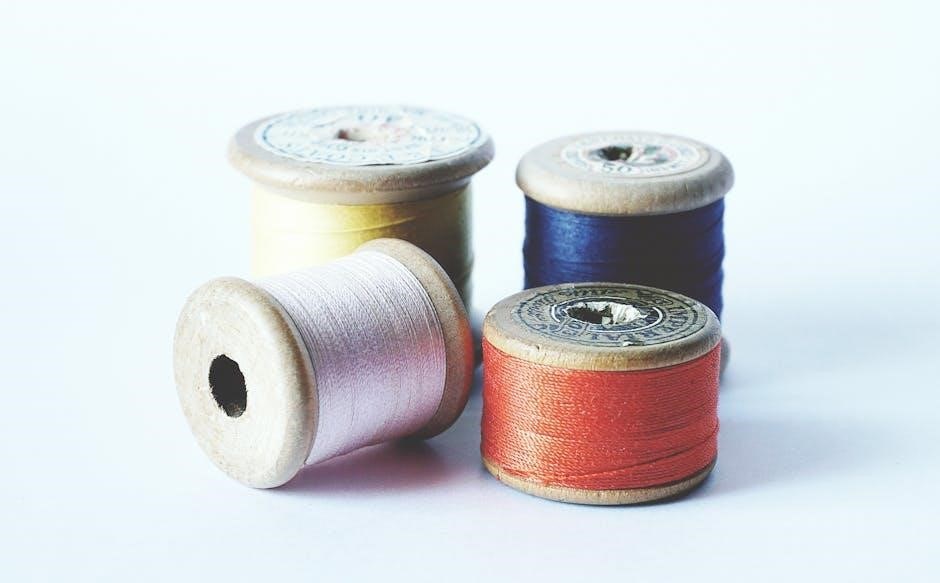
Casting On and Binding Off
Casting on and binding off are essential steps in knitting, ensuring a secure start and finish to your project. These techniques provide a stable edge for seams or buttons.
7.1 Long-Tail Cast-On Method
The long-tail cast-on is a versatile and popular method for beginning knitting projects. It creates a stretchy, even edge and works well for projects like sweaters, hats, and scarves. To start, create a slipknot on one needle. Hold the working yarn in your non-dominant hand, forming a “long tail” of the desired length. Use your dominant hand to pull the yarn into stitches on the needle. This technique ensures a neat, professional-looking edge. It’s especially useful for projects requiring a lot of stitches, as it saves time and yarn. Many knitters prefer it for its simplicity and consistency.
7.2 Basic Bind-Off Techniques
The basic bind-off technique is essential for securing your knitting project. Start by knitting the first stitch. Then, knit the next stitch and pass the second stitch over the first. Repeat this process until one stitch remains. Cut the yarn, leaving a small tail, and pull it through the last loop to secure it. This method creates a neat, firm edge. For a stretchier bind-off, try knitting through the back loop or using a stretchy bind-off method. Proper tension ensures a professional finish. This technique is fundamental for completing scarves, hats, and other knitted items effectively.
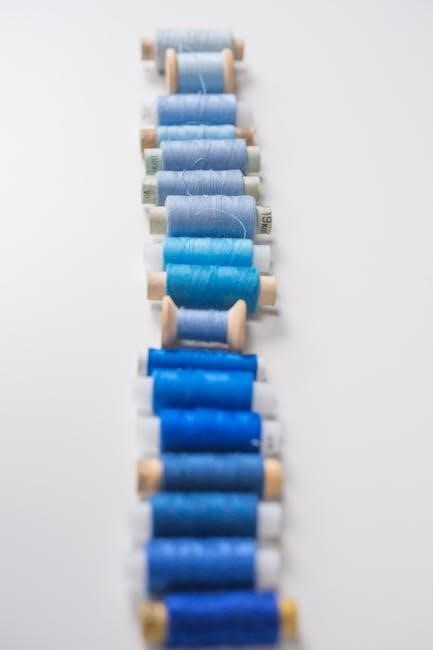
Designing Your Own Knitting Patterns
Designing your own knitting patterns allows for tailored fits and unique styles. Start with measurements, sketch your design, choose yarn, swatch, write clear instructions, and test your pattern.
8.1 Steps to Create a Custom Knitting Design
Creating a custom knitting design involves several structured steps. Start by measuring the intended recipient to ensure a proper fit. Sketch your design, considering shape, style, and details. Select appropriate yarn and needles based on the desired texture and drape. Swatch to confirm gauge, which ensures accurate sizing. Draft a pattern, translating your vision into written instructions. Knit a prototype to test the design and make adjustments. Finally, refine the pattern based on feedback and ensure clarity for others to follow. This process allows for personalized, professional-looking results tailored to specific needs and preferences.
8.2 Tips for Writing Clear Instructions
Writing clear knitting instructions requires precision and clarity. Begin with a detailed materials list, including yarn, needles, and notions. Use straightforward language, avoiding complex jargon. Break down patterns into manageable steps, ensuring each instruction is easy to follow. Include measurements, gauge information, and schematics where necessary. Use bullet points or numbered lists for readability. Test your instructions with a beginner to identify any confusion. Provide visual aids like diagrams or charts to complement text. Ensure consistency in terminology and formatting. Finally, proofread thoroughly to catch errors. Clear instructions make your design accessible and enjoyable for knitters of all skill levels.
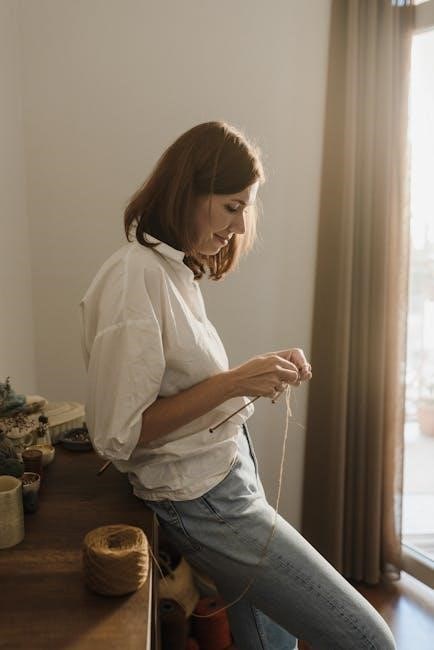
Troubleshooting Common Mistakes
Identify mistakes early to avoid unraveling work. Understand the cause of errors to correct them effectively. Recognizing issues like miscounts or wrong stitches is key to successful knitting projects.
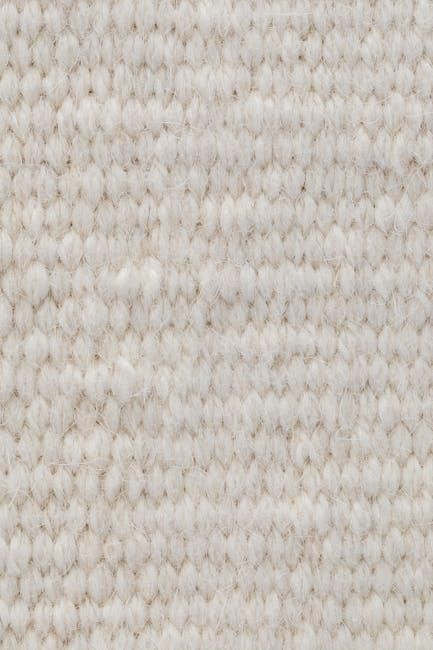
9.1 Fixing Errors in Knitting Patterns
Correcting mistakes in knitting patterns is crucial for achieving desired results. Start by identifying the error, such as a miscounted stitch or incorrect stitch type. For dropped stitches, use a crochet hook to pick them up gently. If a row is misaligned, frogging (ripping out) the work may be necessary. Always refer to the pattern instructions to ensure accuracy. Highlighting complex sections can help prevent errors. Regularly counting stitches and measuring progress ensures early detection of issues. Practice patience and don’t hesitate to seek guidance from tutorials or knitting communities to resolve complex problems effectively.
9.2 Adjusting Sizes and Fits
Adjusting sizes and fits in knitting patterns ensures garments or accessories match the intended measurements. Measure the finished item regularly and compare it to the pattern’s specifications. Swatching is key to determining gauge accuracy, which affects size. If adjustments are needed, modify needle sizes or stitch counts. Lengthening or shortening pieces can be done by adding or removing rows. For a better fit, consider shaping techniques like increasing or decreasing stitches strategically. Always maintain the pattern’s integrity while making adjustments to ensure a professional finish and optimal comfort for the wearer.
Resources for Knitting Enthusiasts
Explore knitting communities, online forums, and social media groups for inspiration and support. Discover books, tutorials, and workshops to enhance your knitting skills and creativity.
10.1 Free Knitting Patterns Online
Discover a wealth of free knitting patterns online, perfect for beginners and experienced knitters alike. Websites like KnittingHelp, Moogly, and The Spruce Crafts offer a wide variety of designs, from simple scarves to intricate sweaters. These platforms provide step-by-step instructions, charts, and photos to guide you through your projects. Many patterns are categorized by skill level, making it easy to find something suitable for your expertise. You can also explore themes like seasonal knits, baby items, or home decor. With so many free resources available, you can experiment with new techniques and create beautiful pieces without spending a dime.
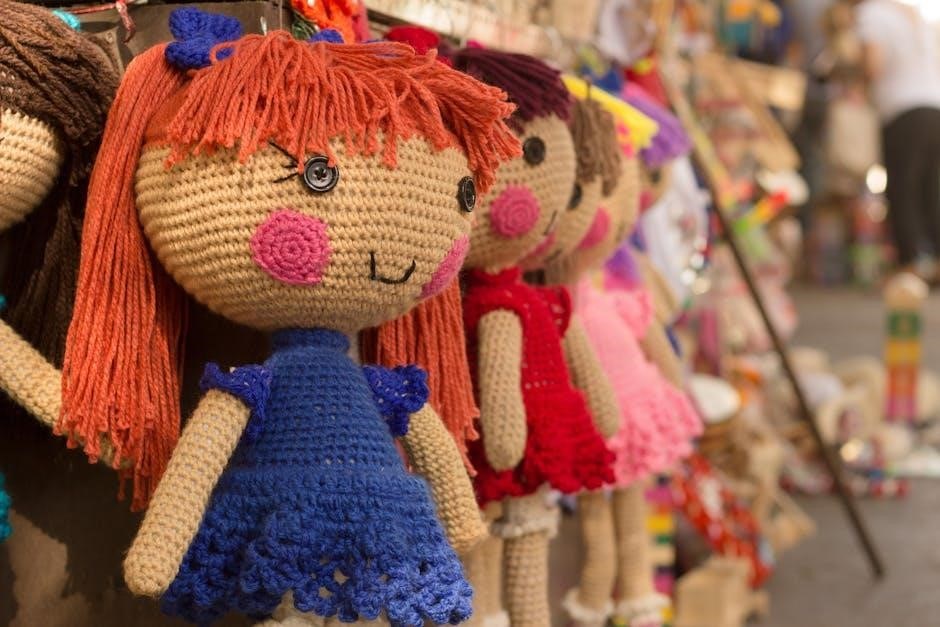
10.2 Recommended Knitting Tutorials and Videos
Enhance your knitting skills with recommended tutorials and videos available online. Platforms like YouTube and Craftsy offer detailed lessons for various techniques. Channels such as Very Pink and Knitting Help provide clear, step-by-step instructions for stitches, patterns, and projects. Websites like Moogly and Creativebug also feature video classes, ideal for visual learners. These resources cater to all skill levels, from basic stitches to advanced methods like cables and lace. They are perfect for mastering new skills or resolving technique-related queries. Utilize these tutorials to refine your knitting abilities and complete projects with confidence and precision.